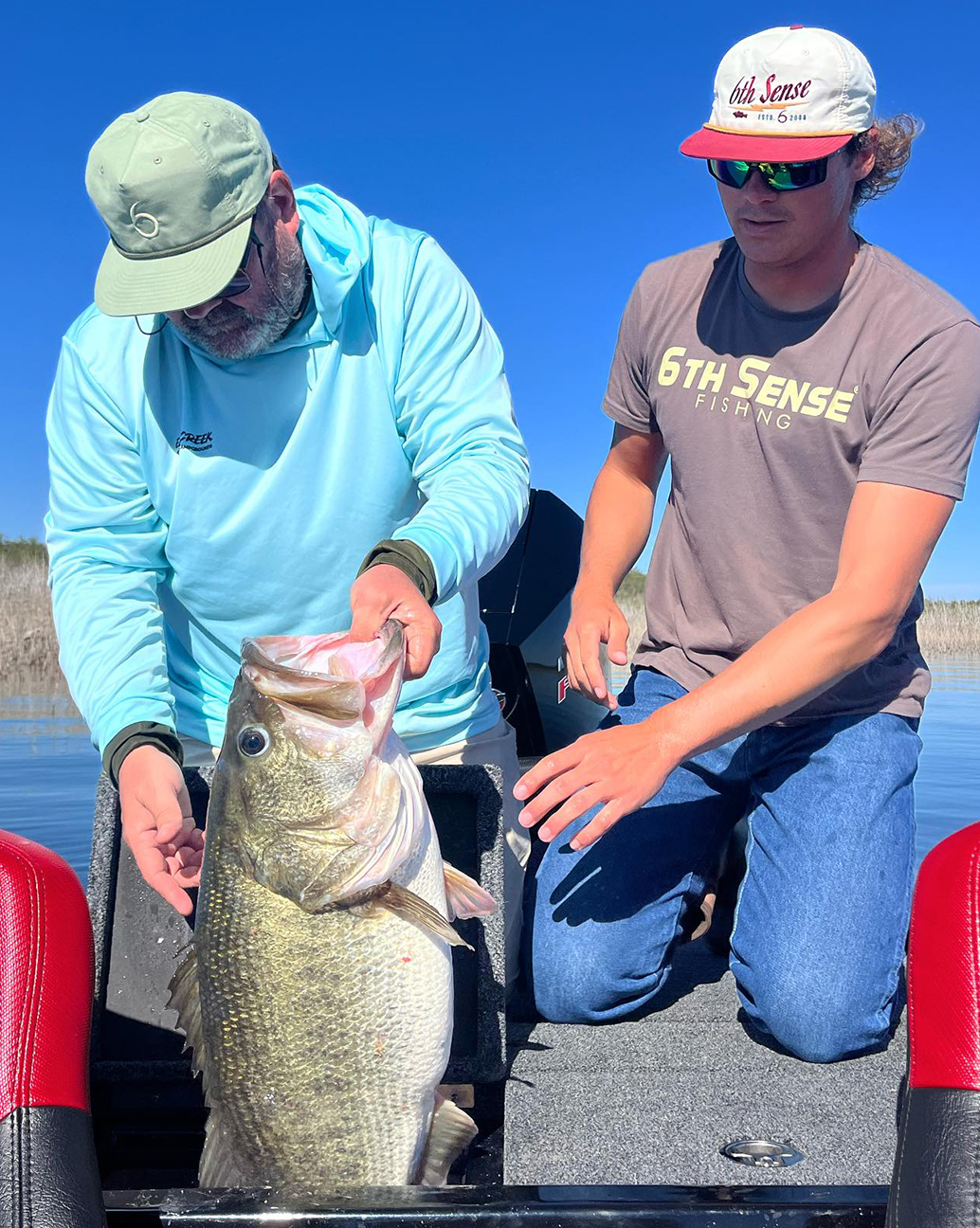
Some call Texas the Lone Star State. I like to call it “Big Bass Central.” An army of giant bass have been caught in Texas over the years. At last count, more than 90 Lone Star reservoirs had produced lake records weighing 13 pounds or more.
The biggest bass are always females.
Former Toyota ShareLunker caretaker and Texas Freshwater Fisheries Center hatchery manager Tony Owens handled hundreds of heavyweight bass over the years before retiring from the Texas Parks and Wildlife Department last summer.
On multiple occasions, Owens found crappie and other sizable forage that were regurgitated by ShareLunkers soon after the big bass were placed in TFFC holding tanks, fittingly called “Lunker Bunkers.”
The biologist also witnessed the gluttonous behavior of big bass more than once. ShareLunkers are often fed rainbow trout during their stays at the TFFC. “A 13–14-pound bass will suck in and swallow a 10–12-inch trout in nothing flat,” said Owens.
Dissecting the Top 50
The Texas’ current Top 50 large-mouth bass list begins with a a state record 18.18 pounder that was caught from Lake Fork in January 1992. It ends with a 15.58 pounder from Amistad in 1989.
Sandwiched in between are 16 more 15 pounders, 25 16 pounders and seven fish in the 17-pound range. More Top 50 bass have been caught during March (16) than any other month, followed by February (13), January (6), May (5), April (3) and November (2).
Two of the Top 50 fish are former state records belonging to Mark Stevenson (No. 2, 17.67 pounds) and the late Earl Crawford (No. 9, 16.90 pounds). Both were caught 9 months apart in 1986. Interestingly, the remainder of Top 50 list has since been completely rewritten. Four former state records no longer make the list.
Kemp and Florida Bass Changed the Game
If it sounds like the face of Texas bass fishing changed in the 1980s, that’s because it did. The credit goes to the late Bob Kemp.
Kemp was chief of the Texas Parks and Wildlife Department’s inland fisheries division in the 1960s and early 1970s. He passed away in December 1986, but his legacy lives on in chapters of Texas big bass lore that continue to unfold.
Kemp paid out of his own pocket to bring the first Florida bass fingerlings to Texas in 1971. The fish are genetically programmed to grow bigger and fast than northern strain large-mouth native to Texas.
The Kemp bass were stocked in growing ponds at the now defunct Tyler Fish Hatchery. There, the little bass grew to become future brooders that would eventually change the scope of Texas bass fishing forever.
There has been plenty of fishy business to pass beneath the bridge since the first stocking of Florida bass went into Lake Murvaul in eastern Texas in 1972. Among other things, the long-time state record large-mouth of 13.5 pounds dating back to 1943 was broken six times on four different lakes during a 12-year period spanning 1980 to 1992. The current record of 18.18 pounds out of Lake Fork turned 32 years old in January.
Several top-notch fish hatcheries were built during the same time frame.
Others were renovated. Those facilities now produce around 7-8 million Florida bass offspring for stocking in dozens of Texas reservoirs each year. To date, TPWD has stocked 302 million Florida bass in 475 different water bodies, according to Todd Engeling, who heads up the agency’s freshwater hatchery program.
Tim Birdsong is the sixth TPWD inland fisheries chief to take the reins with the department since Kemp retired. He says it is no surprise that so many bass anglers are interested in catching big fish.
“Our science has repeatedly shown that stocking Florida bass into Texas reservoirs enhances trophy size potential of black bass fisheries,” he said. “From 1943 to 1980, the Texas state record remained 13.5 pounds. Following the introduction of Florida bass in 1972, numerous bass weighing over 13.5 pounds have been caught. In 2023 alone, 21 fish weighing between 13.5 and 17.03 pounds were entered into the Toyota ShareLunker Program. Texas is now nationally recognized as a destination for big bass fishing, due in large part to the stocking of Florida bass.”
TFFC: The House that Big Bass Built
One of the state’s premier hatcheries is located within the Texas Freshwater Fisheries and Visitors Center in Athens. The facility consists of a state-of-art hatchery, laboratory, aquarium and education center all wrapped into one. It has been referred to as “the house that big bass built.”
The TFFC also serves as home base for Toyota ShareLunker program, TPWD’s high profile public outreach program that has been inviting anglers to donate trophy-sized large-mouth bass for research and breeding purposes ever since Stevenson turned in the first entry in November 1986.
Receiving a new state record as its inaugural entry didn't spell instant success for the program, but it certainly gave organizers the jump start they needed to help sell the concept to fishermen at a time when “catch and release” was gaining early popularity in Texas fishing circles.
Sharing Texas Lunkers
The sales pitch worked. The program has since taken in 669 entries weighing upwards of 13 pounds from 78 public reservoirs scattered around the state while operating under a format that rewards participating anglers with cool prizes and widespread recognition through press releases and social media.
In exchange, TPWD scientists are able to pair big female bass caught between January 1 and March 31 with hand-picked males in hatchery raceways for spawning. The idea is to produce armies of baby bass with shared big bass DNA.
A big percentage of ShareLunker prodigy are stocked back into Texas lakes each year. TPWD has also used the program to completely rebuild its Florida bass hatchery program with female and male offspring from ShareLunkers with pure Florida genes. The agency is calling these fish “Lone Star Bass,” but in reality they are still Florida bass.
Often billed as one of the most successful public relations programs ever launched by the state agency, ShareLunker has generated a wealth of interest in Texas bass fishing while spurring some really neat findings in fish science along the way. One of the most noteworthy discoveries is linked to fish care and proper handling techniques.
All Eyes on ‘Ivie
O.H. Ivie near Ballinger has been the program’s leading donor lake in recent times. Never mind the dozens of 8-12 pounders that have been caught and released at there. It’s the tall number of teeners reported that have grabbed everyone’s attention.
To wit:
• In 2021, the lake produced 15 Toyota ShareLunker entries 13 pounds or larger. Among them were seven 13 pounders, five 14s, two 15s and one 16 pounder.
• In 2022, 20 Sharelunkers over 13 pounds were documented, including seven 13 pounders, 11 14 pounders, one 15 pounder, one 16 pounder and a 17.06 lake record that ranks No. 7 on the state’s Top 50 list.
• In 2023, 21 more fish cracking 13 pounds were reported, including 13 13 pounders, six 14 pounders, a 16 pounder and a 17.03 pounder that ranks No. 8 among Texas’ heaviest bass of all-time.
• 2024 has followed suit. The lake produced 12 Legacy Lunkers this year, including a 15.58 pounder for Kyle Hall of Granbury. Hall’s bass as the No. 37 heaviest Texas bass of all time.
In total, ‘Ivie has six fish that rank among the state’s Top 25; and two in the Top 10. Five were caught during the last three years. The most recent was a 16.65 pounder landed in November 2023 by Mississippi angler Shawn Strength.
Strength was fishing with fishing guide Dalton Smith when he caught Texas’ No. 14 heaviest bass of all-time.
A common denominator in most of these fish is forward-facing sonar. The high-tech electronics allows anglers to see fish in real time, make precise casts to them and see how they react to the bait.
- - - - - -
Matt Williams is a freelance writer based in Nacogdoches. He can be reached by e-mail, mattwillwrite4u@yahoo.com.

